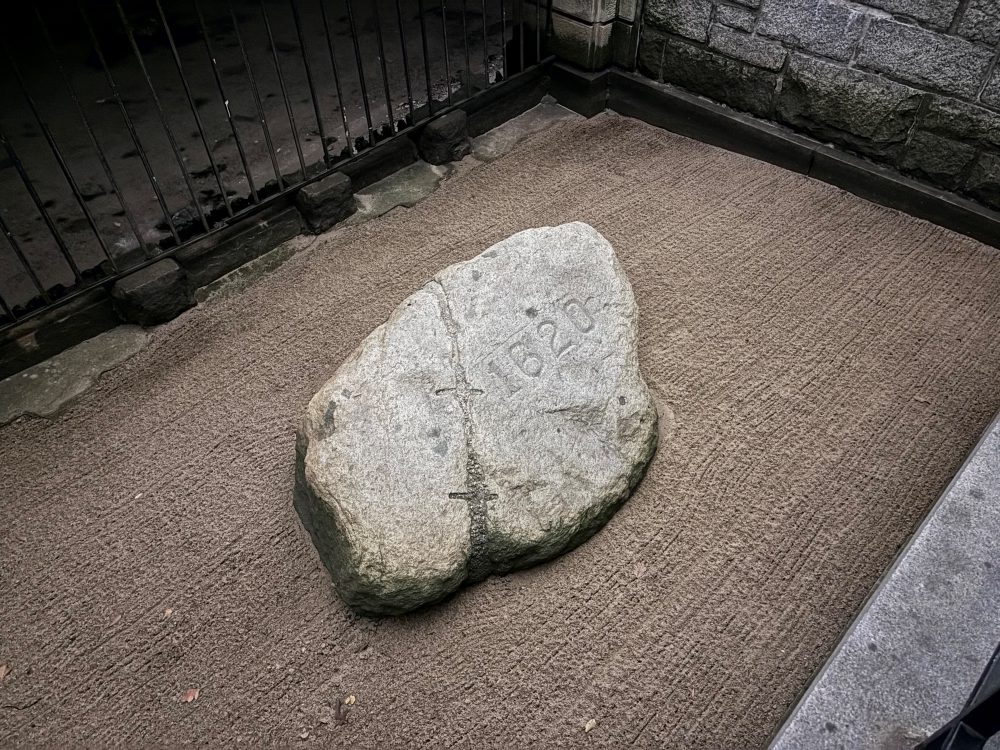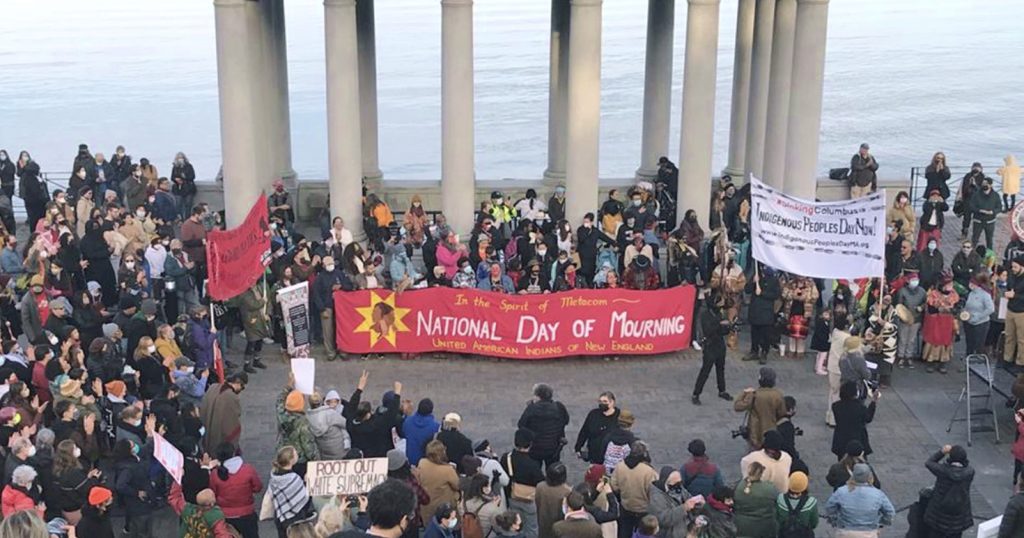Four centuries after British settlers landed here, Plymouth Rock remains the spot every visitor must see, despite the many tired jokes about its size. More than a million people look at it every year.
And with Thanksgiving season in full swing, the 10-ton piece of granite housed under an ornate portico is having its annual moment. In November, tourist buses regularly unload passengers at Pilgrim Memorial State Park (which, appropriately, is the smallest state park in Massachusetts).
Most people spend only a minute or two staring at Rock, which feels like more than enough time to look at a stone that is more about symbolism than factual history. Yet to Lea Filson, president of the See Plymouth tourist organization, it is “the best thing that ever happened to Plymouth.”
Plymouth Rock “is foundational history that makes us authentic and unique,” she said, “an internationally recognized symbol.”
But it wasn’t always that way. The first mention of the Rock wasn’t until 1741, when Thomas Faunce, a notable town resident, told people that his father passed down its origin story. As that tale goes, the settlers stepped on the Rock to bridge the distance between the Mayflower and the shore.
To this day, many believe Faunce’s story or simply acknowledge the possibility that it’s true. The fact or fiction element might not be important, but it did hold value for Faunce, who “even asked to see the rock one more time before his death,” Filson says.
Patrick Browne, executive director of the Plymouth Antiquarian Society, doesn’t exactly say Faunce was completely factual in relaying the story from his late father. He was “an elder of the church, he was an important person in town, and I tend to believe that he believed [the Rock] was where the Pilgrims landed,” Browne said.
“But you know, as far as primary source evidence that they stepped on the Rock, or that the Rock was anything significant to the Pilgrims themselves – we have no sources on that at all,” he added.
In Plymouth founder William Bradford’s 17th century journal chronicling the Mayflower’s voyage and life in Plymouth, there is no mention of the Pilgrims stepping on a stone.
So with such a hazy backstory, why has the Rock been a tourist magnet for hundreds of years? Mostly because of shrewd marketing, and a little levity.
“Plymouth’s tourism industry [has made] an effort to help people understand the symbolism [of the Rock] by using humor. By not getting so totally serious about the Rock,” Filson said.

But not all visitors are won over by the marketing efforts.
“It is free to see the Rock, but I definitely don’t think it’s something you need to see when you go to Plymouth,” said Sage Jay, 20, who often visits the town from her home in Middleborough. Jay prefers the Mayflower II replica ship, which is docked at nearby State Pier.
“I loved the Mayflower growing up and have some great memories with my family there. Especially, the time my brother got super seasick,” she said with a giggle.
Helen Châu Nguyễn Khánh Giao, 21, a Vietnamese student visiting Plymouth with some friends recently, also was not impressed.
“I thought it was pretty underwhelming,” she said. “I was wondering what’s so special about it. And when I found out that it’s not even the actual rock, I think it’s definitely a tourist trap to attract more people to Plymouth.”
But she acknowledged that the Rock is “a thing for people to get curious about history. I also think that they do that to make the arrival [of the Pilgrims] more dramatic.”

Over time, as awareness of how indigenous people were treated by the Pilgrims increased, Plymouth Rock’s image became more complicated.
Native Americans have gathered on nearby Cole’s Hill every Thanksgiving Day since 1970 to observe a National Day of Mourning. Atop the hill, a plaque commemorates “the genocide of millions of their people, the theft of their lands, and the relentless assault on their culture.”
There’s also a famous Malcolm X quote: “We didn’t land on Plymouth Rock. The Rock was landed on us.”
Bob Dylan even hung out at the portico in 1975, at the launch of the legendary Rolling Thunder Revue. Who knows what he thought of its significance?
The Rock has been the scene of many protests over the years – including recent pro-Palestinian demonstrations – and has repeatedly been vandalized with spray paint. (Security cameras now lessen that possibility).
“No statue should ever be vandalized or destroyed,” said Jason Roberts, a history professor at Quincy College. “But on the other hand, communities can have a conversation of, maybe we could move a statue to a museum. Maybe we could move a statue to a battlefield. Or add historical context.”
“I always believe we should have honest conversations about our history,” Roberts said, “and it should be a conversation about the good and the bad.”
Riley Nemes is a senior studying journalism at Emerson College in Boston.

